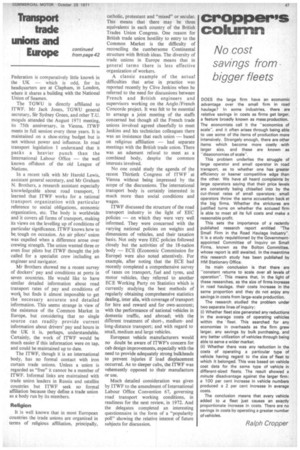No cost savings from.
Page 89

If you've noticed an error in this article please click here to report it so we can fix it.
bigger fleets
DOES the large firm have an economic advantage over the small firm in road haulage? In some industries, there are relative savings in costs as firms get larger, a feature broadly known as mass production. The economists call it the "economics of scale", and it often arises through being able to use some of the items of production more intensively. Strangely enough, there are other items which become more costly with larger size, and these are known as "diseconomies of scale".
This problem underlies the struggle of large operator and small operator in road transport, as to whether one has greater efficiency or keener competitive edge than the other. We have all heard complaints by large operators saying that their price levels are constantly being chiselled into by the cut-throat rates of small operators: small operators throw the same accusation back at the big firms. Whether the strictures are justified turns on whether the accused firm is able to meet all its full costs and make a reasonable profit.
This sets the importance of a recently published research report entitled –The Small Firm in the Road Haulage Industry". It is a study requisitioned by the Governmentappointed Committee of Inquiry on Small Firms, known as the Bolton Committee, whose report is still awaited. In the meantime this research study has been published by HM Stationary Office.
Its main conclusion is that there are "constant returns to scale over all levels of operation". This means that. in the light of these researches, as the size of firms increase in road haulage, their costs increase in the same proportion and they do not enjoy any savings in costs from large-scale production.
The research studied the problem under two separate lines of inquiry: (i) Whether fleet size generated any reductions in the average costs of operating vehicles within the fleet. This searched for any economies in overheads as the firm grew larger. any savings by bulk purchasing, and any better utilization of vehicles through being able to serve a wider market.
(ii) Whether there was any reduction in the costs of operating a particular type of vehicle having regard to the size of fleet to which it belonged. This was based on vehicle cost data for the same type of vehicle in different-sized fleets. The result showed a minute disadvantage against the larger firm: a 100 per cent increase in vehicle numbers produced a 2 per cent increase in average costs.
The conclusion means that every vehicle added to ,a fleet just causes an exactly proportionate increase in costs. There are no savings in costs by operating a greater number of vehicles.
Ralph Cropper












































































































































